What are the Buckaroo Banzai production storyboards?
Buckaroo Banzai production storyboards
Sean Murphy
(This article originally appeared as part of In Medias Res: The Buckaroo Banzai Production Binders By Sean Murphy, Dan Berger, DeWayne Todd, and Steve Mattsson in the August 2019 issue of the World Watch One newsletter.)
The production binders purchased by Ernie Cline are a treasure trove of Banzai materials but the crown jewel has to be the production storyboards. According to Wikipedia, a storyboard is, “…a graphic organizer in the form of illustrations or images displayed in sequence for the purpose of pre-visualizing a motion picture, animation, motion graphic or interactive media sequence.” The storyboards give a look and feel to the script by showing how the shots might be composed for the screen and providing the details needed to convey the script visually.
For example, when the script says that Buckaroo is put into a shock tower by Lizardo, what does that mean? What does the shock tower look like? By looking at the storyboards we know that this:
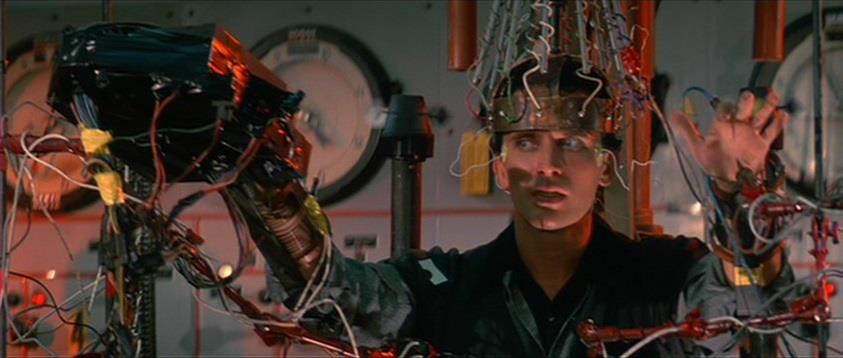
Source: MGM Universal
…started out as this:
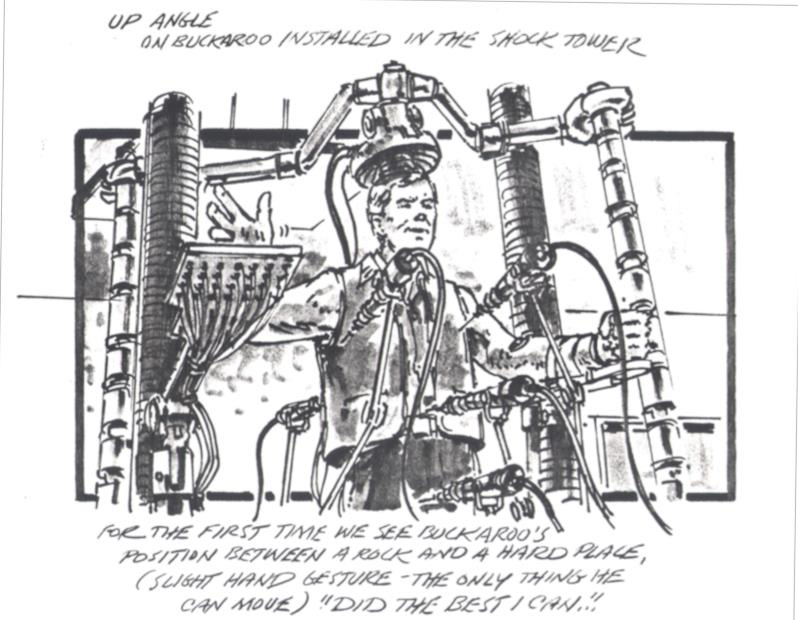
Storyboards also give us the opportunity to see how things can change from this pre-visualization stage to the final film.
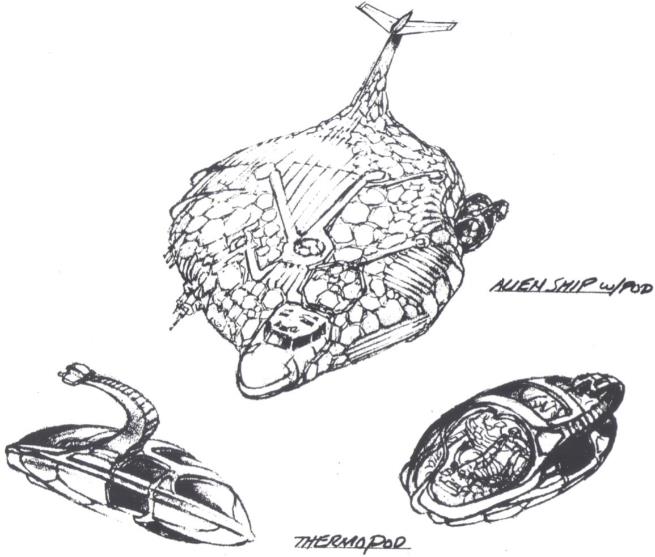
The design of the Lectroid’s escape ship and thermopod, as found in the storyboards, show a more scaly look combined with actual parts from an Earth based ship.
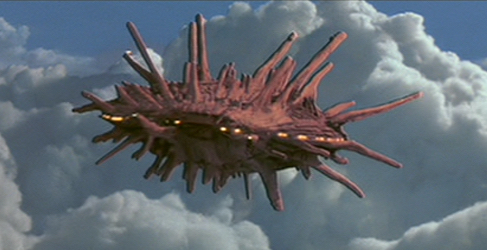
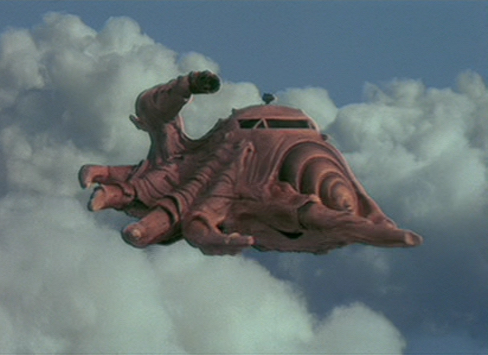
The movie went for a more organic look for both of the Lectroid ships.
The documents found in the production binders are composed of 363 pages of Buckaroo Banzai storyboards, once several duplicate storyboards were removed. There are six full color pages of storyboards that depicted an early concept for the Eighth Dimension.
There were three production illustrators on the crew for Buckaroo Banzai;Tom Southwell, Tom Cranham, and Sherman Labby. We aren’t sure exactly who was the primary storyboard artist, or how the works was divided up. The storyboards cover seven sequences found in the Shields Against the Devil script dated September 17th, 1982 (with the hunter sequence represented twice) and there are not storyboards for every sequence in the film. The storyboarded sequences found in the Essential Buckaroo are:
1) Jet Car is attacked by missiles and goes through the mountain to the Eighth Dimension (156 pages)
2) Emilio Lizardo’s first attempt with an overthruster, which ends with him possessed by Whorfin (28 pages)
3) Three duck hunters discover the Thermopod and Buckaroo Banzai is chased (43 pages)
4) Two duck hunters discover the Thermopod and Buckaroo Banzai is chased (42 pages)
5) John Parker drops off a package at the Banzai Institute (26 pages)
6) Buckaroo drives the Jet Car into Yoyodyne (24 pages)
7) Banzai and Lizardo fight in the sky (17 pages)
8) Banzai Optical effects (8 pages)
There is no way that we can cover all of these storyboards in an article, so we’re just going to focus on the section with the jet car. Although these storyboards are in order, we have removed some in-between pages for space concerns.

The first revelation found in the storyboards is that the Jet Car is actually a Jet CAR, not a truck, as is seen in the film. Source for image: MGM Universal
The second revelation is that the Jet Car is attacked by soldiers with rocket launchers and machine guns, as found in the Shields Against the Devil script. This sequence makes it even more relevant for the Secretary of Defense to be on hand to see what happens.

1. Cam angles round 180º to show Buckaroo intense (cut to)
2. Angle on missile team—tracking Buckaroo’s car at the controls…(cut to)
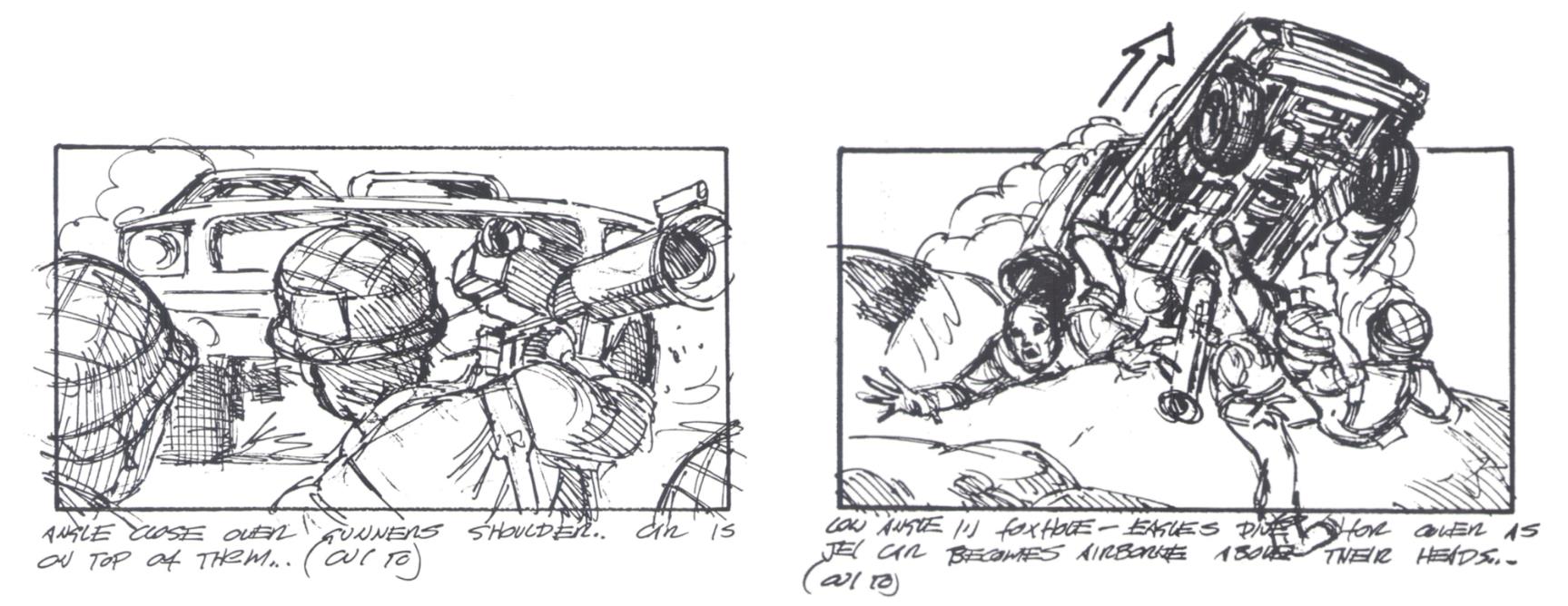
3. Angle close over gunners [sic] shoulder. Car is on top of them…(cut to)
4. Low angle in foxhole—Eagles dive for cover as Jet Car becomes airborne above their heads…(cut to)

5. Angle on expectant Eagles…
6. Angle on Eagles—guns blazing

7. Angle past Eagles down road Buck must pass… completely enveloped in fire…(cut to)
8. Another angle up the road as Jet Car emerges from firestorm—worst ever…(cut to)

9. Angle close on cliff wall—Jet Car impacts (impact EFX?)
10. Finally, the storyboards take us through the Eighth Dimension and do something we’ve never seen in a storyboard before; they show what the Eighth Dimension might look like in color!
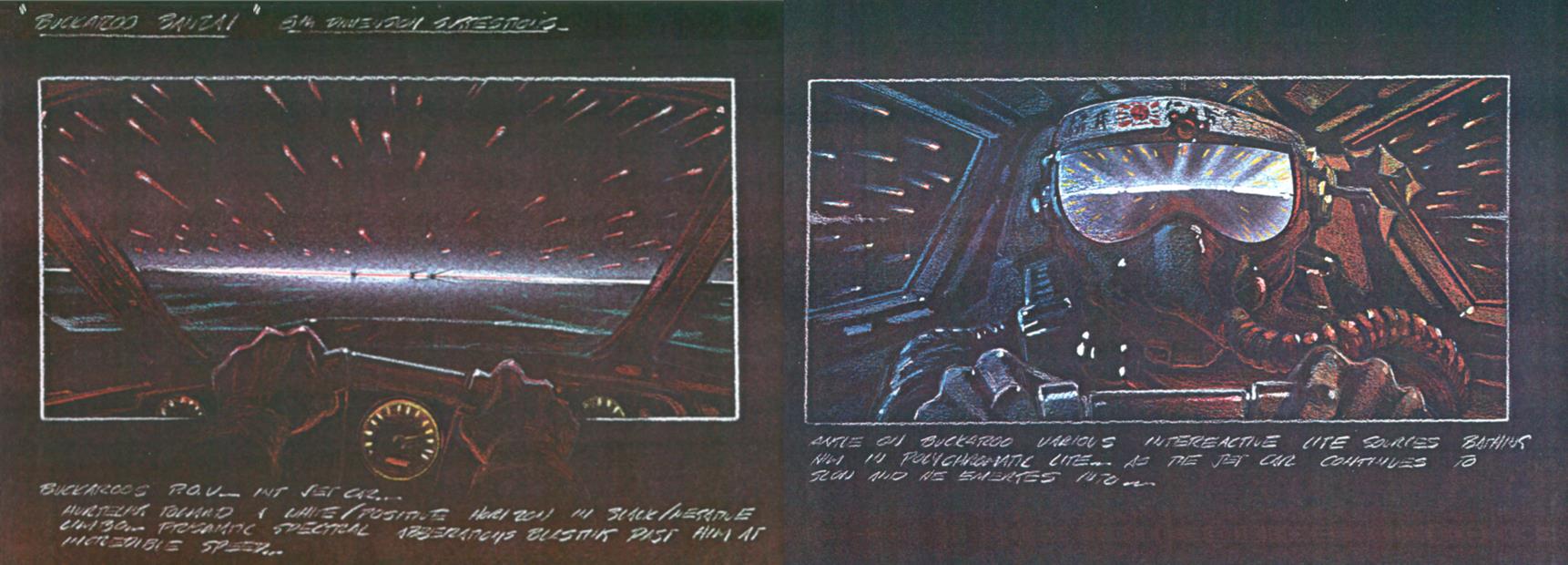
11. “Buckaroo Banzai” 8th Dimension Suggestions Buckaroo P.O.V.—Int Jet Car…hurtling toward a white/positive horizon in black/negative limbo…prismatic spectical [sic] abberations [sic] blasting past him at incredible speed…
12. Angle on Buckaroo various interactive lite [sic] sources bathing him in polychromatic lite [sic]…as the Jet Car continues to slow and he emerges into…

13. White 8th dimensional limbo…inhabited by wraiths and beasts of all variety…some crawling, some walking and others flying thru the air…
14. Follows 8th Dimension Angle on another rocky cliff— Jet Car emerges from solid rock (same FX as entering) (cut to)
You may wonder why, if the jet car attack sequence was storyboarded, it did not end up on screen. The easiest answer to this question is that the script used for the storyboards, Shields Against the Devil: Another Buckaroo Banzai Thriller by Earl Mac Rauch (Second Draft 9/17/82), was not the final shooting script. By the time they got to the final script, called Buckaroo Banzai by Earl Mac Rauch (Shooting Script, Revised Third Draft, 4/29/83), the jet car attack sequence had been removed.
While it’s sad that the sequence was cut, it’s easy to imagine that budget constraints probably had something to do with its removal. The jet car attack sequence would not have been cheap to shoot, especially with the need for extras, vehicles, weapons, the fake version of the Kremlin for Buckaroo to drive through (See storyboard images from this in next article), and the cost of stunt work and explosions.
The storyboards provide a fascinating look at how much visual thinking and pre-work goes into putting together a film and how the storyboards help bring the script to life. While there is not a one-to-one correlation between the storyboards and the released film, you can clearly see the film we love outlined there.
The jet car attack sequence was not the only difference between the script in the production binders and the final shooting script as we’ll see in the following Script Comparison article.
Mystery Solved!
By World Watch One Staff
One of the great benefits of perusing the production binders is the journey of discovery they provide. Sometimes the documents reveal the creative roads not traveled during the making of Buckaroo Banzai. Other times they answer questions we didn’t even think to ask before, like, “Why did the Black Lectroid thermopod look like a flying dinosaur in the sky and a gigantic beach-ball on the ground?”
The storyboards for an early version of the duck hunters sequence provide the answer: The beach-ball is actually an “escape bladder” that oozes from the bottom thermopod. It then plops to the ground with the Black Lectroid crew inside.
The top tier of page ten and the bottom two tiers of page eleven of the storyboards for this sequence show the filmmakers’ intention.
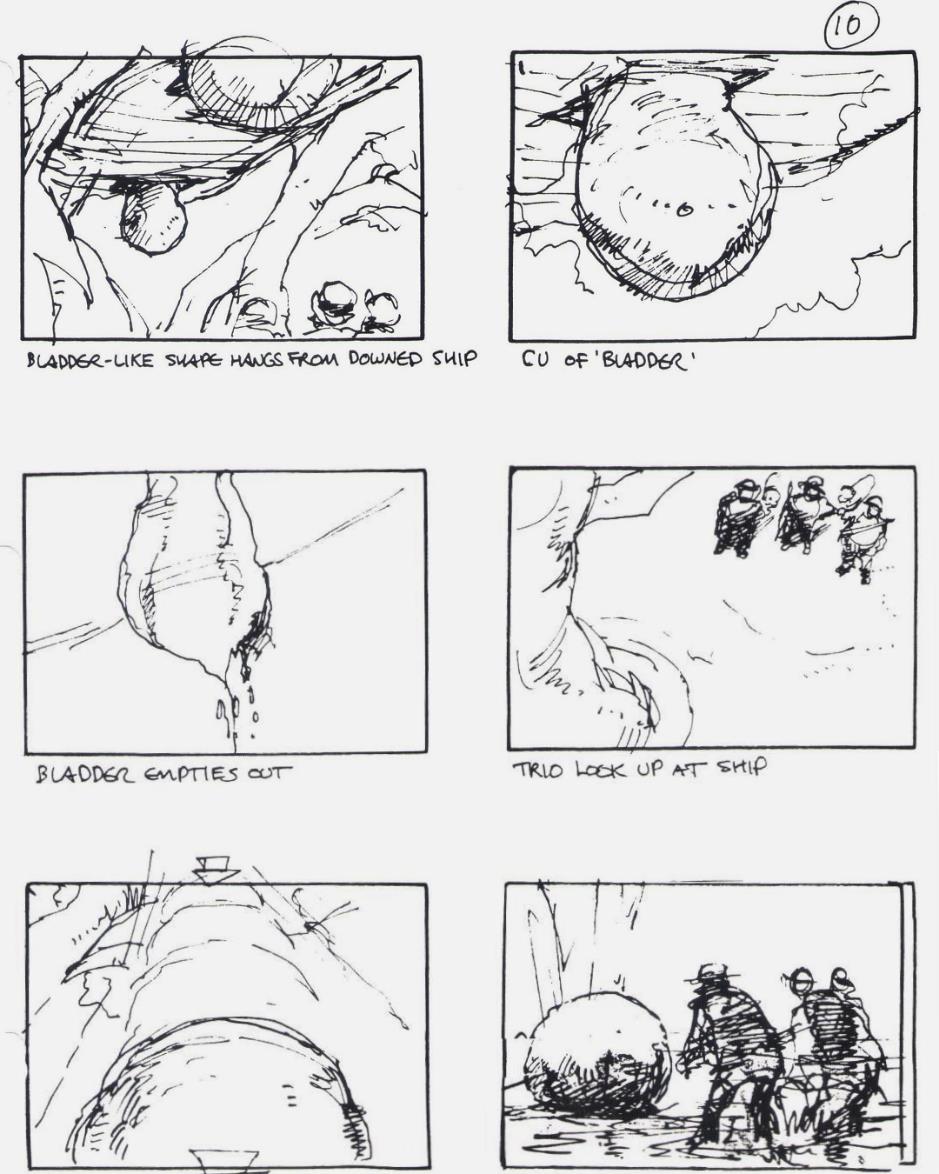
Telling the whole story: While these pages of the storyboards reveal some additional details about the ill-fated flight of the Black Lectroid thermopod (Right), they do not tell the tale in full. It is clear from the DVD and Blu-ray extras for Buckaroo Banzai that additional footage from the duck hunter scene was shot that never found its way into the final film. Exactly how much more and whether or not it included this sequence remains a mystery.
What are the Buckaroo Banzai Production Binders?
- What are the Buckaroo Banzai
production illustrations?
- What is the Buckaroo Banzai
production script comparison?
- What are the Buckaroo Banzai production storyboards? (You
Are Here)
- What is the Essential Buckaroo in the Buckaroo Banzai production binders?
This page was last updated on May 10th, 2020.
Maintained by Sean Murphy [figment@figmentfly.com]
